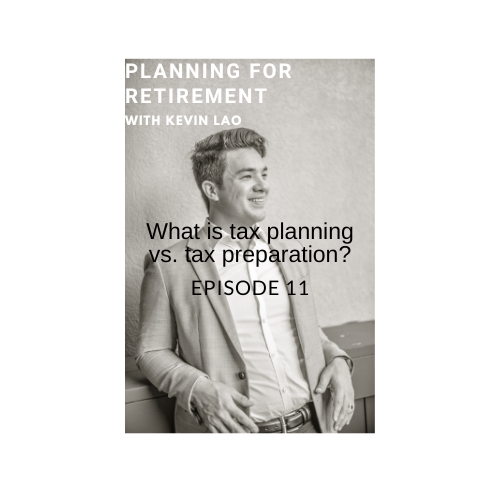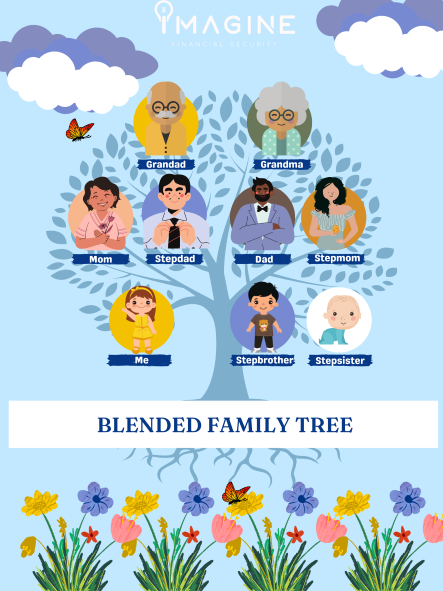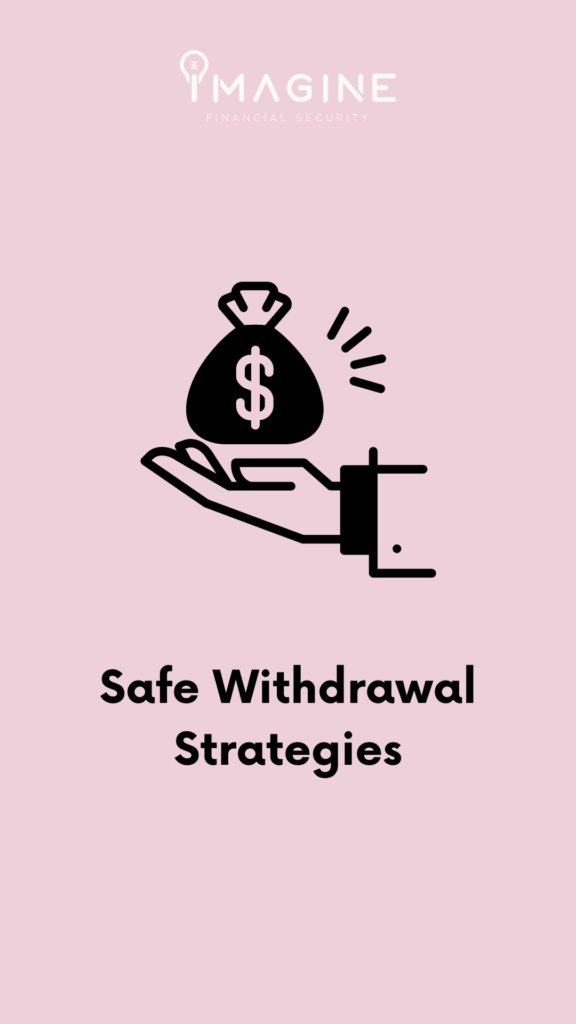Episode 11: What is tax planning vs. tax preparation?
What is tax planning vs tax preparation?
What is Tax Planning vs. Tax Prepartion
Kevin Geddings 0:21
Six minutes now after 11 o’clock, we’re live from St. Augustine, we hope that you’re having a good day so far. Kevin Lao joins me here live in the studio. And of course, he is an expert when it comes to financial planning and the like, Kevin, how are you doing?
Kevin Lao 0:36
I’m doing well, Kevin, thank you for having me. As always, yes,
Kevin Geddings 0:39
Imagine financial security, just imagine it if you can. I know a lot of our listeners are a little nervous these days, you know, they made the really bad mistake of looking at their January 30. Second quarter, you know, IRA statements that rolled in in the second week of July, you should never have opened those,
Kevin Lao 0:57
you know, a lot of clients, and people are telling me that they’ve been throwing their statements in the fire pit. So maybe that’s a good solution.
Kevin Geddings 1:03
Kevin has been doing this work for a long, long time. And he’s based right here in Northeast Florida. He’s worked with people from all over the country. And we’re going to talk today about tax planning versus tax preparation. And I know what you’re thinking, hey, it’s July, what? Why are we talking about taxes? You don’t do that until the end of the year or April? But no, there’s a reason why you would want to talk about tax planning now, right, Kevin?
Kevin Lao 1:25
Yeah, this is, first of all, please don’t take this as tax advice. Everyone has their own unique situation. But you know, there’s two different schools of thought you have tax preparation, and you have tax planning. And, a lot of people think tax preparation is tax planning. What that means is, in March or April, you gather your 1099s and your W2s and you throw them at your accountant last minute and make them work to death until they file your returns and figure out how much you owe. Or if you have a refund. And there’sonly a few things that you can actually do to impact your tax liability at that point in time. Whereas tax planning is proactive, where you’re not even just looking at the current year in terms of your tax projections and opportunities to reduce your taxable income now, but you’re looking years into the future, to look for opportunities to mitigate your tax exposure, particularly in your retirement years.
Kevin Geddings 2:17
Yeah, there are specific things you can do. And it’s amazing, so many people don’t do these things. I know, you may be thinking, well, you know, the government or somebody can give you some advice or guidance is really on you, or it’s on us individually to figure out a way to minimize, you know, our tax risk.
Kevin Lao 2:35
And it’s a boring topic, I was telling one of my neighbors, I was like, Hey, I’m gonna jump on the radio and talk about tax planning. He’s like, that sounds exciting. It’s not exciting for most people. And so that’s one of the main reasons they hire a firm, it’s not just for investment management, but it’s for this tax planning concept. And one of the basic things that pretty much everyone can do that’s contributing to, let’s say, a 401 K plan or an IRA, and they’re still in the accumulation phase, as to whether, weigh the pros and cons of whether or not you’re doing a traditional 401K or an IRA contribution versus a Roth 401 k or IRA contribution. And the basic concept of it is, do you think taxes are going to be higher or lower for you in the future? If you think taxes are going to be higher for you in the future, whether it’s because your income is going to be higher in the future, or you think potentially the government’s going to raise taxes in the future. Remember, at the end of 2025, the tax cuts and Jobs Act is sunsetting. So tax brackets, in general, unless they change, things are going to go up for most people. So if you’re in the camp, Hey, you think tax rates are probably going up over time, you may want to consider doing a heavier dosage of Roth contributions, whether it be in a Roth IRA or Roth 401 K. And you know, you’ve got to be careful with this. Because once you enroll in a 401 K plan with your company, the default for 99% of companies out there is in the traditional 401 K plan. And so you need to look and see your options. Can you do a Roth 401 K contribution or 403 B contribution or Roth TSP, if you work for, you know, military or government. And so this is a an easy sort of analysis to figure out, those Roth versus traditional contributions for retirement.
Kevin Geddings 4:07
Hey, if you’re just hopping in the vehicle, that’s the voice of Kevin Lao. And of course, he is the principal at imagine financial security that’s located right here in Northeast Florida. And they work with individuals just like you and me, and he will help you get to a better place in terms of your retirement. We’re all worried, Kevin, about running out of retirement savings, you know, outliving our retirement, but you help people with that all the time.
Kevin Lao 4:31
Yeah, I mean, that’s, that’s the number one concern, they don’t want to be a burden on their loved ones. You know, and a big a big part of that is health care. And, Fidelity does a study every year. Right now, a 65 year old couple is expected to spend $300,000 on health care costs alone during retirement, and that’s not even including long term care costs. That’s a totally different issue. One of the things that I’m a big proponent of, if you have five or 10, or even more years of working, is whether or not you can qualify for a Health Savings Account better known as an HSA. I wrote a blog post about this on my website, I believe this is the most tax efficient vehicle you can utilize to save for retirement. It is a triple tax benefit, tax deductible contributions, tax free Growth and Tax Free distributions, as long as those distributions are used for healthcare related expenses. Now, the trick is, don’t get super aggressive spending those HSA contributions during your working years. Do the best you can to pay out of pocket for a lot of those healthcare costs. Because what you can do is you can turn around and invest that HSA take advantage of the market being down invest that HSA to let that grow for the next 15-20 years of tax free growth. So you can actually pay for those health care costs that Fidelity mentioned in retirement.
Kevin Geddings 5:48
So you can actually take HSA funds and invest those in the market. Yeah,
Kevin Lao 5:52
Most of the time, once you hit $1,000 in savings. There are limits, once you’ve contributed more than $1,000, then you can start to invest the surplus, so you have to keep a certain amount of cash, and then you can invest a certain amount. For me, I invest every dollar that I can in the HSA and I do my best to never touch the HSA. You can touch it before 59 and a half for health care related expenses. So, if you have an emergency medical event that happens, by all means you need to consider this as an option. But if you can let those continue grow tax free, it’s the most efficient vehicle you can utilize to save for retirement because it can be also used to pay for those long term care costs that I mentioned, it could also be used to pay for long term care insurance premiums tax free. So there’s a lot of benefits that you can utilize with the HSA, once you get to retirement.
Kevin Geddings 6:34
Wow. And there’s no cap in terms of how big that HSA account can become?
Kevin Lao 6:39
There is no cap on how big it can become, there is a cap on how much you can contribute. So for 2022 for if you’re single $3,650 If you’re married filing jointly $7,300 per year in annual contributions. So think about that. $7,300, over a 10 year period, you just contributed $73,000 into a tax free health care plan that hopefully you’ve invested wisely. And hopefully that doubles a couple of times over the next 20 years. And all of a sudden now you have 210 $220,000 in an HSA.
Kevin Geddings 7:10
These health savings accounts, Kevin Lao. I mean, sometimes you’ll see little ads at your bank, are there other ways? I mean, how would you recommend setting up these accounts and can they be set up through an investment account approach? Or how does that normally work?
Kevin Lao 7:26
Ya know, there are a lot of different carriers The first qualification to use an HSA is you have to have a high deductible health plan. If you don’t have a high deductible health plan, you can’t qualify for an HSA. And there’s some rules around that. So, just do a Google search and say, Hey, do I qualify for an HSA? But if you’re with an employer, a lot of times, they’ll say, hey, this type of health program, you can utilize an HSA, this one, you cannot. For military service, or government, if you’re on TRICARE, those cannot qualify as high deductible health care plans. So you cannot use an HSA if you’re military tricare. But if you’re civilian, and you’re working for an employer that has different healthcare options, go to them and say, hey, which which of these offers a high deductible plan with an HSA and which of them are kind of your traditional health care programs. And they usually partner wit a broker to set up the actual HSA account.
Kevin Geddings 8:17
moving funds into an HSA a health savings account, that’s just part one aspect of tax planning that Kevin Lao can help you with, once again tax planning is taking advantage of all the legal vehicles that are out there that will reduce your tax exposure, right?
Kevin Lao 8:33
Absolutely. Yes, I mean, a big one right now, we were talking a lot about this off air, with the markets down, we’re officially in a bear market since last time I was on the show. Which is basically measured by a 20% drop from a previous high. So many people out there might have some losses, some embedded losses in their investment accounts. And a lot of times, like we talked about, people are kind of throwing away their statements, they’re burying their head in the sand, but these losses can be utilized to offset potential capital gains or income in the future. And so the strategy is better known as tax loss harvesting, it has to be done inside of a taxable account, it cannot be done in an IRA, whether it be a Roth or even a 401K plan, it has to be in a non qualified account. But if you recognize the loss, meaning you sell that investment at a loss, now you actually have a Realized loss. And so let’s say you sold an investment at a loss for $50,000, that loss can be utilized to offset capital gains, whether it be this year or in future years, or reduce your taxable income, up to $3,000 per tax year. And the best part is, there’s no limitations on how many years you can carry that forward. So if you’re recognizing a lot of these losses, while the markets down, you can sell these investments at a loss, and we’ll talk about reinvesting that in a second and utilize those losses for many, many years to come. Now, the key is to avoid the wash sale rule. And so what that means is you cannot sell an investment and then turn around within 30 days and buy the same investment, or a substantially identical investment. Okay? So if you buy an individual stock, it’s pretty simple. You can’t sell Apple and buy Apple in the next 30 days. Otherwise, it’s a wash sale rule, it’s the same investment. But let’s say you have a mutual fund, like fidelity s&p 500 fun if you sell that, and bought, let’s say, the Vanguard s&p 500 fund, that might be a substantially identical investment. So you’ve got to be careful with that wash sale rule. The rule is within 30 days, you can’t turn around and buy an identical or the same security within 30 days otherwise, the tax loss harvest doesn’t work.
Kevin Geddings 10:36
Hey, we’re talking about tax planning versus just tax prep. And obviously Kevin Lao knows his stuff. Imagine financial security that’s imagine financial security located right here in Northeast Florida, you can always reach him at imaginefinancialsecurity.com cleverly enough, imaginefinancialsecurity.com or call the office number 904-323-2069 That number again, 904-323-2069. We’re gonna put all of Kevin’s information up on our social media platforms as well at WSOS radio on Facebook and Instagram. We’ll be right back.
Kevin Geddings 12:10
The Beatles here on 103.9. We had to play tax man because while we’re talking about tax planning versus tax preparation with Kevin Lao, he, of course is the principal at Imagine financial security, imagine financial security located right here in our part of the world. And he helps individuals, with all sorts of financial issues mostly focused on trying to get you ready for retirement. That could be retirement for you in the next 10 or 15 years. Or maybe you’re one of these, you know, super successful 20 Somethings that wants to retire like Kevin at age 40.
Kevin Lao 12:39
I wish. Having three kids under three, I think I’ve got a little ways to go. But yeah, that’s a good point. Early retirees is definitely a hot topic and it’s not necessarily retiring, and then not doing anything. It’s retiring from your day job, and then at 45 or 50, doing a passion project and having that financial independence to do so. So I think we talk a lot about the FIRE movement, financial independence to retire early. So it’s gaining a lot of traction.
Kevin Geddings 13:09
If you know somebody who’s in that situation, or you’re in that situation, I would encourage you to reach out to Kevin. Today though, we’re talking about tax planning, some various aspects of it. In the last segment, we talked about health savings accounts and how they can be a very interesting vehicle that can be more than you think. The way I was thinking of it before Kevin stopped by today, which is, well just a pool of money that you set aside tax free, and then you spend it down on your eyeglasses and things like that. But it can actually be a much more creative vehicle than that. So he has a great blog posts at his website, imaginefinancialsecurity.com that you can read about his thinking on health savings accounts. We were talking about, obviously, tax loss harvesting, with a lot of investments that have taken a hit here in 2022. There’s some benefits there. Let’s talk about one of the old school things even baby boomers out there, we’ve been told all of our lives, hey, you make a charitable contribution, give some money to the Salvation Army and you get to write that off your taxes.
Kevin Lao 14:03
Absolutely. This is probably one of the one of the topics that is that is misunderstood by just about everybody. They think they’re donating to charity, and they’re getting a tax deduction for it. But studies have shown that nine out of 10 taxpayers since the tax cuts and Jobs Act Act went into effect in 2017. Nine out of 10 taxpayers are taking the standard deduction. So it doesn’t matter what you’re doing with charitable donations. It’s technically not making a difference from a tax standpoint, because the standard deduction was multiplied by two with that legislation, which is, set the roll off at the end of 2025. But for now, most people are not itemizing deductions, and therefore those charitable donations don’t matter. Except for $600 for a couple and then $300 For a single if you’re if you’re doing the standard deduction and you’re doing charitable donations, you can take $300 If you’re a single filer and $600, if you’re married and actually reduce your taxable income, but everything above that is not dedutible if you’re taking the standard deduction.
Kevin Geddings 14:59
So I would imagine people that worked with you. And some of our listeners have some significant retirement savings. If they want to make charitable contributions, you can give them some advice, right?
Kevin Lao 15:08
Yes, one of the big ones, one of my favorite strategies is called a QCD, or qualified charitable distribution. Okay, so this is for individuals that are over 70 and 1/2 that have Ira plans, they can donate up to 100,000 dollars per year from their IRA to a charity. And this works extremely well, when you turn 72, and you’re taking required minimum distributions. The amount you have to take out per the IRS rules based on your life expectancy table. So if you’re taking out, let’s say, $50,000, because the IRS makes you, and normally you give, let’s say, $10,000, to charity, okay, well, you can take $10,000 from that required minimum distribution and donate it straight to charity. And that is never included in your ordinary income. Okay, so it’s better than a tax deduction. So don’t even worry if you’re itemizing, or taking a standard deduction that is not included in your ordinary income. So now, it looks like your distribution was only $40,000, not $50,000. So for folks that have, let’s say, Social Security income coming in, or they have maybe a pension from the military, or government, maybe they don’t need all of the required minimum distributions, and they’re sitting there complaining, oh, the IRS, they make me take out all this money. And if they’re charitably inclined, or maybe they just want to reduce their taxable income, they can start to do those QCDs each and every year and have a QCD plan is what I like to call it. Especially if it’s going to reduce your tax bracket. And that’s another thing, we can get into all day long, but tax brackets also impact what you pay for Medicare premiums, and QCDs work extremely well coincided with both of those two topics.
Kevin Geddings 16:41
It just strikes me, Kevin, there’s so many folks that don’t know this stuff, because the government doesn’t say, Hey, here’s a little pamphlet where we’re gonna explain how we’re going to nail you on taxes, you really have to go out there and search and find on your own.
Kevin Lao 16:54
Yes, all this information is online. That’s like the nice thing about the internet, you can do Google searches all day long, and read about QCDs and required minimum distributions or charitable donations. I think the value that my clients find, in working with someone like my firm, or other financial planners out there is that we can get that information that you can find yourself and apply it to what is relevant to your situation, and maximize those rules in your favor based on your circumstances and your financial situation.
Kevin Geddings 17:27
Well, what you do with people is you work with them in a tailored way, right? Because it sounds cliche, but the reality is, we are all different. Even if you have the same amount of money, you have half a million or a million in assets, or 2 million, or what have you, how you want to utilize those funds in retirement is greatly different from person to person.
Kevin Lao 17:45
That’s why that’s one of the reasons why we named our firm what it is, I like to have people imagine what financial security means to them, it means different things to different people. You know, one other thing real quick if we have time to talk about is the donor advised fund which is also the acronym d A F, donor advised fund. And so if you’re not 72, if you’re not taking those required minimum distributions yet, what you can do is you can make these contributions to a donor advised fund, which think of it as like your own personal charity. So if you’re charitably inclined and you typically make, let’s say five, or six, or even 10,000 dollars per year to a certain charity, but you’re not getting a tax deduction for it because you’re taking the standard deduction. It doesn’t really matter how much you donate to charity, you’re already getting that standard deduction, what you can do is we call it bunching, bunching those contributions. So in one year, make a larger donation into this DAF, this is still your account. But the nice thing is, let’s say you put in $50,000, which might be five years worth of donations, now you can deduct those contributions, because it’s above that standard deduction. And then what you can do with that DAF is completely up to you from there. It has to be used for charitable donations going forward. So you can’t donate it to, you know, little Johnny’s college fund, or pay yourself a salary, it has to be a legitimate 501 C3 organization. And you can start to make donations from that donor advised fund on a tax free basis. And the cool thing is similar to the HSA, like we talked about, you can also invest that donor advised fund in a diversified pool of funds. So you can set that account up with fidelity or Schwab or Vanguard or whatever it might be. Get that invested according to a plan that works for you and your risk tolerance. And you can actually potentially have more money to give to charity over time. And it’s also kind of a multigenerational tool. I see clients utilize it teaching their kids to be charitably minded, those types of things. And again, you can actually take the deduction for those contributions because of the bunching rule.
Kevin Geddings 19:43
And that’s the voice of Kevin Lao. If you just hopped in the vehicle, and we’re taking a little break from the music we’re gonna get back to the songs are here in just a second. And we’re talking about tax planning versus tax preparation, what can be done to minimize your tax risk, regardless of the income that you have or whatever your assets are? Kevin works with individuals on the He’s issues and on investment issues overall to make sure that you have the retirement that you always wanted. So we’ll be right back. Talk to me about Medicare planning.
Kevin Lao 20:17
Yeah. So Medicare planning is an interesting one. When you turn 65, you’re going to enroll in Medicare, and you’ve been paying into the system for your entire career. Your employer takes out a certain percentage of your paycheck to pay into the Medicare system, what a lot of people don’t realize is that your premium for Part B is dependent on your modified adjusted gross income. Okay, and so based on that modified adjusted gross income, you might pay what’s called an Irma penalty, okay. And so, if you look at if you look at different things, like your Social Security, or a pension that you might have, or perhaps it’s required minimum distributions, once you add all that up, you need to see, hey, is your premium going to be higher for Medicare, and that also coincides with those Roth conversions to potentially pay a little bit more tax now to not only save in tax your tax brackets going forward, but also to reduce what you might pay for your Medicare premiums? Once you’re 65 or older.
Kevin Geddings 21:15
if you have any questions about tax planning, or just investing in general and getting ready for a secure retirement, you can get in touch with Kevin Lao by going to the website. Imaginefinancialsecurity.com. That’s imaginefinancialsecurity.com. So Kevin Lao, we see all these ads on television all the time for life insurance, that you can be 70 years old, and be a diabetic with one of your arms falling off, and you can still get a term life insurance, you know, but you help people with these issues, right, figuring out whether life insurance is a good investment or not?
Kevin Lao 21:47
I know a little bit too much about life insurance and long term care insurance. But it’s a topic that’s super important. And I think it’s one that’s often misunderstood by by the consumer. But the basic idea around life insurance in retirement is, if you have a goal to leave a legacy to your children, or a charity, or maybe you have an estate tax issue, life insurance could be one of the most efficient tools you can utilize to pass on to the next generation, because it’s income tax free to those beneficiaries. Whereas if you think about your 401 K, or an IRA plan, those are going to be taxed to your beneficiaries, assuming those traditional contributions are tax deferred contributions. And, think about the secure Act, which is another piece of legislation that passed at the end of 2019. It’s made the rules on on passing those 401 ks and IRAs to the next generation, extremely tax inefficient. So, if your kids are working at Google, or some big tech company or Amazon, they’re making way more money than you ever made, you need to think about that, what is their tax situation going to be if they inherited your IRA tomorrow? So life insurance can be a good solution to offset some of those tax liabilities upon the inheritance of those 401Ks and IRAs. And again, it’s it’s one of those things, the earlier you do the life insurance planning, the more cost effective it can be. And so I work with my clients in terms of shopping carriers with them, looking at all of the different landscapes, all these different contracts, and help them understand what they currently have and what they might potentially need. Because these contracts are extremely complicated. I think the insurance companies, they like to make things complicated, but that’s one thing I can help my clients is like looking at their current life insurance, looking at their current long term care, does it make sense to refresh and upgrade based on what the markets doing now, and based on what their long term goals might be?
Kevin Geddings 23:41
Yeah, well, it’s a great vehicle. There’s all these different vehicles that are out there, whether it’s health savings accounts that we were talking about earlier, you know, obviously taken advantage of some of the investment losses that many of us have experienced, since the beginning of 2022, charitable donations, how those can be structured with donor advised funds, all that stuff. I know if it all sounds like a foreign language to you, that’s okay. Because it’s not a foreign language to Kevin. That’s what he does all day long, and he actually enjoys it. It’s fun. You can tell. I enjoy getting to spend time with Kevin on the radio because not everybody loves what they do. But he actually loves what he does.
Kevin Lao 24:18
I you know it’s fun. I mean, helping people plan for retirement. It’s an exciting time in people’s lives. But it’s also very unnerving, because there’s a lot of uncertainty, a lot of unknowns. The media likes to play on fear. So people read things and they say, hey, does this apply to me? Does this not apply to me? So I think I think my clients really appreciate an objective third party that’s not affiliated with the media, telling them what what is relevant for them and what they need to be concerned about.
Kevin Geddings 24:43
I highly recommend working with Kevin once again, imaginefinancialsecurity.com That’s imaginefinancialsecurity.com The phone number 904-323-2069. As promised, here’s the phone number 904-323-2069. You’ll get a sense of Kevin In his bio, his thinking on a variety of financial issues, if you check out the website, that’s where you may want to start. Imaginefinancialsecurity.com. Kevin LAO. Thank you very much for coming by. We learned a lot.





